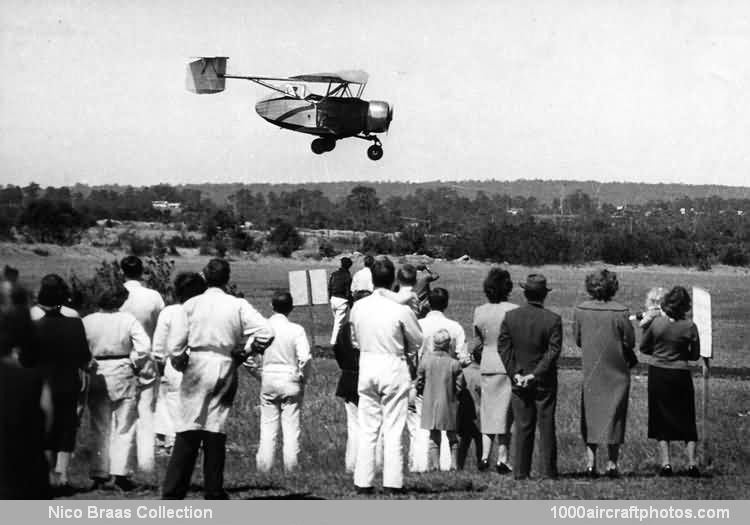The prototype PL7 agricultural aircraft was designed by KSAS' Chief Designer Luigi Pellarini. One of Australia's most prolific post-WW II aircraft designers, Pellarini also designed the Transavia PL-12 Airtruk, the Fawcett 120, the Victa R2, and several more. Designed and built in only sixteen months, specifically for top dressing, crop spraying and other agricultural purposes, the unorthodox layout PL7 first flew on September 20, 1956. The aircraft was lost in a hangar fire in 1958, and the project was halted."
Wings: Single-bay unequal-span biplane. NACA 6212 wing section. Aspect ratio 6.8 (upper), 6 (lower). Incidence 4° (upper), 3° (lower). Lower wings with welded steel tube spars and ribs and light alloy leading edges attached to hopper. Upper wing light alloy torsion box spar and steel tube ribs. All wings fabric covered. Streamline steel tube strut bracing. Frise type ailerons in upper wings. Total area of ailerons 21.6 sq.ft (2.0 sq.m).
Fuselage: Mild steel tank of welded construction served as main fuselage structure and hopper. Forward face of tank unit attached the engine-mounting frame and nose wheel boom. Steel tube cockpit section, metal covered, bolted to rear face of tank unit.
Tail unit: Fabric covered. Tail plane carried on two 4 in (0.10 m) diameter tubular steel booms which projected from upper wing center section and were braced to fuselage tank structure. Twin fins and rudders mounted below tail plane. Areas: tail plane and elevator (total) 64 sq.ft (5.95 sq.m), fins and rudders (total) 24 sq.ft (2.23 sq.m).
Landing gear: Fixed tricycle type with interchangable Goodyear main and nose wheels. Hydraulic toe-operated brakes on main wheels, with nose wheel steering by rudder bar. Rubber-in-torsion springing was used throughout.
Power plant: One 400 hp Armstrong Siddeley Cheetah X seven-cylinder radial engine driving a Fairey-Reed fixed-pitch metal airscrew. Provision for engines up to 600 hp driving constant-speed airscrews. Fuel tank in rear fuselage section beneath pilot. Fuel capacity 60 gal (227 l). Two 84 gal (318 l) auxiliary fuel tanks carried under wings could also be used to contain spray chemicals. Oil capacity 8.4 gal (31.8 l).
Accommodation: Enclosed single-seat cockpit with sliding canopy in rear fuselage section. Second person could be accommodated in hopper for ferrying.
Equipment: Hopper for fertilizer, dust, seed or liquid. Outlet under lower wing center section, designed for rapid interchange of base plate carrying either fertilizer louvers, seeding or dusting gates, or air-driven pump and distributors for spraying. Built-in copper spray booms in lower wings, with provision for a large number of standard spray nozzles. Plastic-lined tank, suitable for both solid and liquid loads. Capacity 45 cu.ft (1,274 l). Provision under lower wings for electrically operated quick-release racks for carriage of supplies, fence posts, etc.
